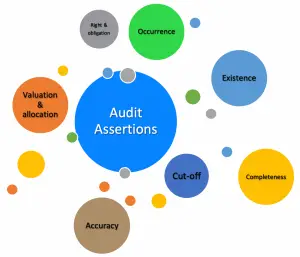Audit Assertions
Definition
 Audit assertions, financial statement assertions, or management’s assertions, are the claims made by the management of the company on financial statements. The moment the financial statements are produced, the assertions or the claims of management also exist, e.g., all items in the income statement are assured to be complete and accurate, etc.
Audit assertions, financial statement assertions, or management’s assertions, are the claims made by the management of the company on financial statements. The moment the financial statements are produced, the assertions or the claims of management also exist, e.g., all items in the income statement are assured to be complete and accurate, etc.
The preparation of financial statements is the responsibility of the client’s management. Hence, the financial statements contain management’s assertions about the transactions, events and account balances and related disclosures that are required by the applicable accounting standards such as US GAAP or IFRS.
The audit assertions can provide us the clues on the potential misstatements that might occur on financial statements. Likewise, we usually use these assertions to assess external financial reporting risks.
In this case, we can determine the different types of misstatements that could occur for each of the relevant audit assertions and then develop auditing procedures that are appropriate to respond to the assessed risks.
Thus, as auditors, we have responsibilities to perform suitable auditing procedures in order to provide the evidence necessary to persuade that there is no material misstatement related to each of the relevant assertions in the financial statements.
List of Audit Assertions
There are seven types of audit assertions that are listed in the table below:
| Audit Assertions | Transactions and events | Account balances | Description |
|---|---|---|---|
| Existence or occurrence | Occurrence | Existence | Transactions or events recorded actually occurred during the accounting period.
Items recorded actually exist at the balance sheet date. These two audit assertions are similar; the difference is that occurrence is for income statement transactions while existence is for balance sheet items. |
| Right and obligation | Right and obligation | The company has the right to control and use its assets and have obligations to pay its liabilities.
Right and obligation assertion is only for balance sheet items only. |
|
| Completeness | Completeness | Completeness | All transactions, events, assets, liabilities, and equities that should have been recorded have been recorded in financial statements.
We test this audit assertion for both income statement transactions and balance sheet items. |
| Accuracy, or valuation and allocation | Accuracy | Valuation and allocation | Amount related to transactions and events have been recorded appropriately.
Items in the balance sheet have been appropriately evaluated and allocated to reflect their actual economic value. |
| Cut-off | Cut-off | Transactions and events have been recorded in the correct accounting period.
Opposite to right and obligation, we test the audit assertion of cut-off for income statement transactions only. |
|
| Classification | Classification | Classification | Transactions and account balances have been properly classified in financial statements. |
| Presentation and disclosure | Presentation and disclosure | Presentation and disclosure | Financial statements are presented in a form unstainable by the public.
Sufficient and appropriate disclosures have been made on related transactions, events and account balances. |
Example
For example, we examine the office supplies expense $3,500 in the general ledge recorded on 18 Jul 2019 by inspecting the supplier invoice, purchase order and receiving report.
What audit assertions do we test here?
By inspecting the supporting documents above, we test the audit assertions as below:
- Occurrence: whether the expense actually took place with the evidence of the receiving report that should be agreed to the quantity in the purchase order.
- Accuracy: whether the expense amount is matched with the amount in the invoice which should be agreed to the quantity and price in the purchase order.
- Cutoff: whether the expense recorded is in the correct period by verifying it with the date in the receiving report.
The above procedure is also known as “three-way matching” which refers to the matching of three supporting documents, including invoice, purchase order and receiving report.